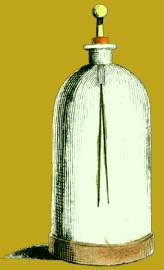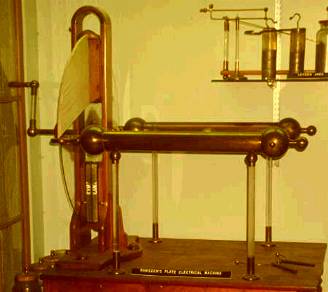
 |
By 1709, Francis Hauksbee at the Royal Society in London discovered that by putting a small amount of mercury in the glass of Von Guericke's generator and evacuating the air from it, when a charge was built up on the ball and then his hand placed onto it, it would glow. This glow was enough to read by and was similar to the phenomenon known as St. Elmo's Fire which was the name given to a strange glow seen around ships in electrical storms. Unknown to him he had created the Neon Light.
Between 1729 and 1736, two English friends, Stephen Gray and Jean Desaguliers performed a series of experiments which showed that a cork or other object as far away as 800 or 900 feet could be electrified by connecting it to a rubbed glass tube with materials such as metal wires or hempen string. They found that other materials, such as silk, would not convey the effect. As a matter of fact, they discovered in early, painstaking experiments that the distant object would not become electrified if the transmission line made contact with the earth, but only if they separated or insulated it from the earth by suspending it on silken threads.
Charles François de Cisternay Du Fay discovered two types of static electricity, and that like charges repel each other whilst unlike charges attract. Du Fay announced that electricity consisted of two fluids: "vitreous" (from the Latin for "glass"), or positive, electricity; and "resinous," or negative, electricity. This was the 'two-fluid theory' of electricity, which was to be opposed by Benjamin Franklin's 'one-fluid theory' later in the century.
During much of the eighteenth century, England and France were the centers of electrical study and innovation, but during the early 1740s, there was a great burst of invention in Germany. Bose's use of a suspended metal conductor and his early experiments with thread became the basis of the later collector, or charge comb, of the electrical machine. Johann Winkler and Gordon, the two chief claimants for the invention of the cylinder generator, worked in Germany. And Winkler is probably the inventor of the friction cushion. He made electrical machines that worked on the back-and-forth principle of the pole lathe, and also machines that used Hauksbee's multiplying wheel.
In 1745 Jean-Antoine Nollet developed a theory of electrical attraction and repulsion that supposed the existence of a continuous flow of electrical matter between charged bodies. Nollet’s theory at first gained wide acceptance, but met its nemesis in 1752 with the publication of the French translation of Franklin’s "Experiments and Observations on Electricity". Franklin and Nollet found themselves on opposite sides of current debate about the nature of electricity, with Franklin supporting action at a distance and two qualitatively opposing types of electricity, and Nollet advocating mechanical action and a single type of electric fluid. Franklin's argument eventually won and Nollet’s theory was abandoned.
Sir William Watson experiments in 1747 to determine the velocity of electricity are of particular interest. The general belief at that time was that electricity was faster than sound, but no accurate test had as yet been devised to measure the velocity of a current. Watson, in fields north of London, laid out a line of wire supported by dry sticks and silk which ran for 6.4 km. Even at this length the 'Velocity of Electricity was instantaneous.' Resistance in the wire was also noticed but apparently not fully understood, as Watson relates that 'we observed again, that although the electrical compositions were very severe to those who held the wires, the report of the Explosion at the prime Conductor was little, in comparison of that which is heard when the Circuit is short.' Watson eventually decided not to pursue his electrical experiments concentrating instead upon his medical career, but he continued to support others in presenting evidence to the Royal Society and became a champion of Benjamin Franklin.
| In 1748 Nollet invented one of the first electrometers, the electroscope, which showed the presence of electric charge by using electrostatic attraction and repulsion. Nollet is reputed to be the man who first applied the name "Leyden jar" to the first device for storing electricity. As early as the mid 18th century, Du Fay noted that electricity may be conducted in the gaseous matter adjacent to a red-hot body (hot metal). In connection with his experiments with his thread suspended on glass poles, Du Fay noted that a certain amount of the current is lost, being given off to the surrounding air. |  |
Du Fay recommended, therefore, that the cords experimented with be wrapped with some nonconductor that it should be "insulated" ("isolee"), as he said, first making use of this term.
Ewald Jurgens (George) von Kleist, German administrator and cleric, who discovered in 1745 the Leyden jar, a fundamental electric circuit element for storing electricity, now usually referred to as a capacitor. The device was independently discovered at about the same time by Pieter van Musschenbroek, who investigated it more thoroughly than Kleist.
 | In the mid 1700s, as the study of electricity became popular, efficient ways of producing electricity were sought. The generator developed by Jesse Ramsden was among the first electrostatic generators invented. Electricity produced by such generators was used to treat paralysis and muscle spasms, and to control heart rates. Other medical uses of electricity included filling the body with electricity, drawing sparks from the body, and applying sparks from the generator to the body. |
The first true electrometer, a device for measuring electric potential by means of attraction or repulsion of charged bodies, came from Horace-Bénédict de Saussure who placed in 1766 the strings and balls inside an inverted glass jar and added a printed scale so that the distance or angle between the balls could be measured. It was de Saussure who discovered the distance between the balls was not linearly related to the amount of charge.
Charles-Augustin de Coulomb developed the law of electrostatic attraction in 1781 as an outgrowth of his attempt to investigate the law of electrical repulsions as stated by Joseph Priestley of England. To this end he invented sensitive apparatus to measure the electrical forces involved in Priestley's law. He also established the inverse square law of attraction and repulsion of unlike and like magnetic poles, which became the basis for the mathematical theory of magnetic forces developed by Siméon-Denis Poisson. He wrote seven important treatises on electricity and magnetism which he submitted to the Académie des Sciences between 1785 and 1791 in which he reported having developed a theory of attraction and repulsion between bodies of the same and opposite electrical charge. He demonstrated an inverse square law for such forces and went on to examine perfect conductors and dielectrics. He suggested that there was no perfect dielectric, proposing that every substance has a limit above which it will conduct electricity. These fundamental papers put forward the case for action at a distance between electrical charges in a similar way as Newton's theory of gravitation was based on action at a distance between masses.
| In 1789 Franz Aepinus developed a device with the properties of a condenser (now known as a capacitor.) The Aepinus condenser was the first condenser developed after the Leyden jar and was used to demonstrate conductive and inductive electricity. The device is constructed so that the space between the plates can be adjusted and the glass dielectric (insulating plate between them) can be removed or replaced with other materials. Instruments of this type became popular in the second half of the 18th century and were the subject of experiments and interpretation by many "Electrical Physicists", such as Franklin, Aepinus and others. Volta announced it was an original piece of apparatus, arising out of his electrophorus. He gave it its present name "capacitor" and claimed he invented it. He explained it function on the basis of his theory of electrical atmospheres. |
|
Luigi Galvani published his essay "De Viribus Electricitatis in Motu Musculari Commentarius" (Commentary on the Effect of Electricity on Muscular Motion) in 1791. He concluded that animal tissue contained a heretofore neglected innate, vital force, which he termed "animal electricity," which activated nerve and muscle when spanned by metal probes. He believed that this new force was a form of electricity in addition to the "natural" form that is produced by lightning or by the electric eel and torpedo ray and to the "artificial" form that is produced by friction (i.e., static electricity). He considered the brain to be the most important organ for the secretion of this "electric fluid" and the nerves to be conductors of the fluid to the nerve and muscle, the tissues of which act as did the outer and inner surfaces of the Leyden jar. The flow of this electric fluid provided a stimulus for the irritable muscle fibres, according to his explanation.
Galvani's scientific colleagues generally accepted his views, but Alessandro Volta, the outstanding professor of physics at the University of Pavia, was not convinced by the analogy between the muscle and the Leyden jar. Deciding that the frog's legs served only as an indicating electroscope, he held that the contact of dissimilar metals was the true source of stimulation; he referred to the electricity so generated as "metallic electricity" and decided that the muscle, by contracting when touched by metal, resembled the action of an electroscope. Furthermore, Volta said that, if two dissimilar metals in contact both touched a muscle, agitation would also occur and increase with the dissimilarity of the metals. Thus Volta rejected the idea of an "animal electric fluid," replying that the frog's legs responded to differences in metal temper, composition, and bulk. Galvani refuted this by obtaining muscular action with two pieces of the same material. But the ensuing controversy was without personal animosity. Galvani's gentle nature and Volta's high principles precluded any harshness between them. Volta, who coined the term galvanism, said of Galvani's work that "it contains one of the most beautiful and most surprising discoveries." Nevertheless, partisan groups rallied to both sides.
In retrospect, Galvani and Volta are both seen to have been partly right and partly wrong. Galvani was correct in attributing muscular contractions to an electrical stimulus but wrong in identifying it as an "animal electricity." Volta correctly denied the existence of an "animal electricity" but was wrong in implying that every electrophysiological effect requires two different metals as sources of current. Galvani, shrinking from the controversy over his discovery, continued his work as teacher, obstetrician, and surgeon, treating both wealthy and needy without regard to fee. In 1794 he offered a defense of his position in an anonymous book, "Dell'uso e dell'attività dell'arco conduttore nella contrazione dei muscoli" (On the Use and Activity of the Conductive Arch in the Contraction of Muscles), the supplement of which described muscular contraction without the need of any metal. He caused a muscle to contract by touching the exposed muscle of one frog with a nerve of another and thus established for the first time that bioelectric forces exist within living tissue.